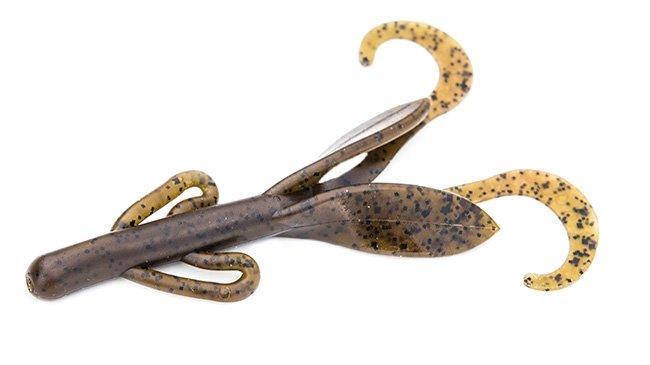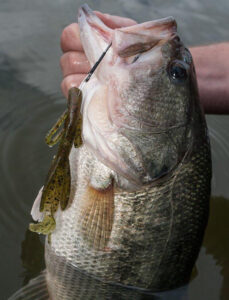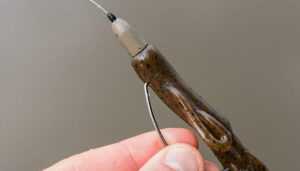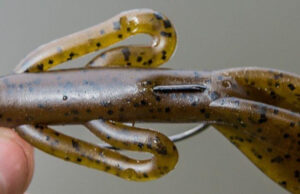With the plethora of new soft plastics that are continuously introduced into the bass fishing industry, it has become easy to overlook some of the tried-and-true baits that helped develop our sport into what it is today. When Ed Chambers created the Zoom Brush Hog, he changed the industry forever. He further proved the importance of action and water displacement—even if it doesn’t look like anything a bass normally eats.
The Zoom Brush Hog is available at:
I use this bait throughout the entire year and you will never find my boat without multiple packs in the front compartment. There are several reasons I’ve become such a believer in this bait over the years.
- Water displacement
- Versatile
- Durable
- Affordable
Excellent action without overpowering finicky fish
As I already said, the Zoom Brush Hog doesn’t resemble any type of natural bass forage. But the beauty of this bait is in its incredible action and water displacement properties. It’s a large, thick bait that measures 6 inches in length, but it seems to appeal to even the most finicky bass. I think a large part of that is because it requires very little rod movement to displace water.
We’re always taught to slow down when the bite is tough. Whether the bite gets tough due to weather conditions, time of year or fishing pressure, a slow and deliberate approach can be essential at times. I’ve studied this bait extensively in shallow, clear water and its back ribbon-tail “tentacles” twirl and spin with the natural motion of the water. The large paddles, also located near the rear section of the bait, lazily undulate as the bait falls to the bottom. To get maximum action from this bait, it’s not necessary to aggressively hop or quickly drag it across the bottom. In other words, you could say that it requires very little “angler involvement”.
As a result, the Brush Hog offers a large profile that still attracts larger-than-average bass, but it doesn’t overpower finicky fish when conditions may call for a more finesse approach. I’ve caught countless bass on a full-sized Texas-rigged Brush Hog when many anglers couldn’t get bit on small shaky heads and finesse worms.
Unique profile that lends itself to versatility
I’m enamored with versatile soft plastics because let’s face it—fishing is expensive at times. In addition, having one bait that works well for several applications decreases clutter, time consuming organization tasks and the frustration of digging through your tackle bag looking for what you need.
I can confidently say that the Zoom Brush Hog is one of the more versatile soft plastics I’ve found. Regardless of the conditions or time of year, there always seems to be a way to get bites with it.
- Texas rig—The Texas rig is probably the most popular way to fish a Brush Hog and it might be my favorite. Its larger profile represents a substantial meal to bass, but it doesn’t have many appendages to get “hung” on heavy cover. This is why I love flipping and pitching the thickest stuff I can find with the Brush Hog. It slides through small openings easily and because it’s a fairly heavy bait, it’s very easy to skip underneath docks—even for beginners.
- Carolina rig—In the summer months, I love to chunk a full-sized Brush Hog on the ol’ ball and chain rig when the bass are keying on larger forage. Although it’s big, it actually sinks very slowly which makes it an excellent choice for a Carolina rig—it stays above vegetation well and keeps itself in the strike zone very well. As the weather cools, I’ll use a Baby Brush Hog on a Carolina rig as the bass head back to their deep water haunts. I’ve experience great hookup ratios and a lot of bites this way.
- Jig trailer—It doesn’t look pretty when you hang the Brush Hog on the back of a jig, but I’ve had incredible success doing so. Whether you’re flipping shallow cover or dragging a football jig over deep structure, this is an excellent way to eliminate small bites. When I get a bite on this rig, I fully expect it to be 3 pounds or better.
- Weightless—You don’t see many folks doing this, but the Brush Hog works very well when you swim it on the surface on a weightless Texas rig. Its tails buzz on the water’s surface and create a lot of disturbance, making it a great choice when targeting shallow grass lines and paralleling the shoreline or seawalls.
It’s a workhorse
To be honest, I’ve probably caught close to ten bass on a single Zoom Brush Hog several times in my lifetime. After about five bites, you might have to bite a small portion of the head off, but either way—that’s pretty awesome in my opinion.
The head of the Brush Hog is very thick, resulting in excellent stability on an Offset EWG Worm Hook. You can skip it repeatedly, bang it against docks and hook a few fish without needing to constantly reposition it throughout the day.
The body of the bait is also very durable. Even after multiple fish catches, the hook point stays penetrated which saves a lot of time. There are a lot of creature baits on the market that require a lot of “babysitting”, as I call it, but I rarely have to “check” on my bait while I’m fishing.
Affordable
Aside from catching a bunch of bass, I think the Zoom Brush Hog’s popularity is largely due to its affordable price point. The full-sized Brush Hogs are priced at $3.99 per 8-pack while the Baby Brush Hogs are priced at $3.99 per 12-pack. When you combine the competitive price point with its durability and versatility, this bait is very appealing to anglers on a budget. Not to mention, they’re available in 61 color selections.
If you haven’t tried the Zoom Brush Hog yet, I really think you owe it to yourself. They have been and always will be a major staple in my soft plastics collection.
The Zoom Brush Hog is available at:
















